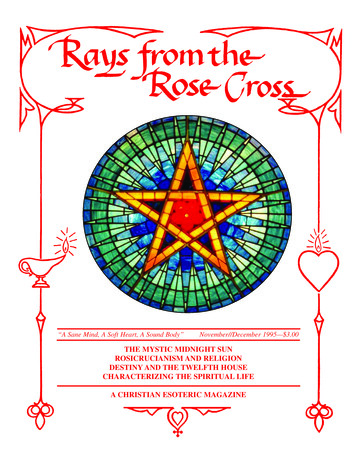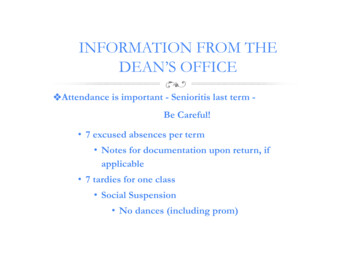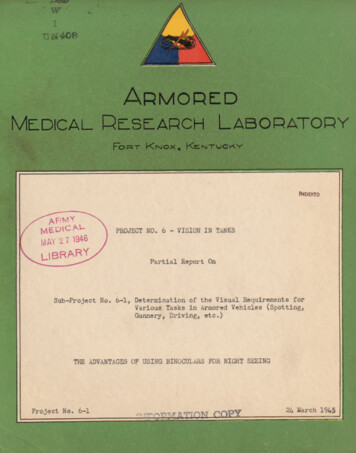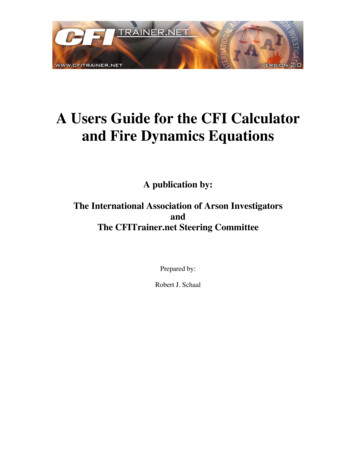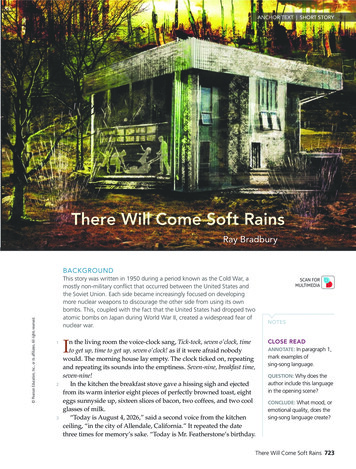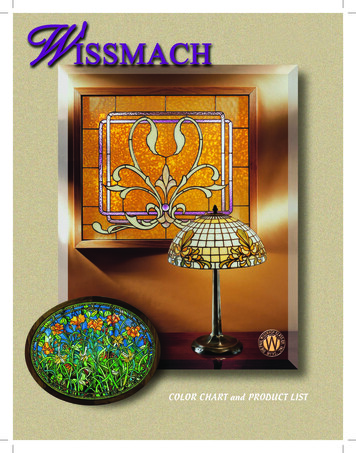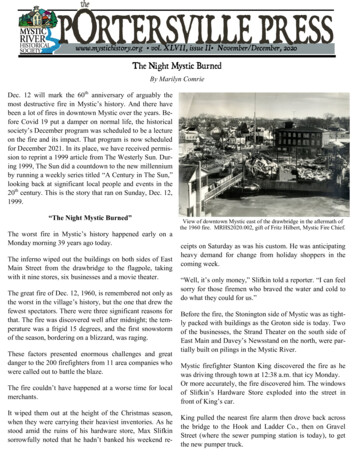
Transcription
www.mystichistory.org vol. XLVII, issue II November/December, 2020The Night Mystic BurnedBy Marilyn ComrieDec. 12 will mark the 60th anniversary of arguably themost destructive fire in Mystic’s history. And there havebeen a lot of fires in downtown Mystic over the years. Before Covid 19 put a damper on normal life, the historicalsociety’s December program was scheduled to be a lectureon the fire and its impact. That program is now scheduledfor December 2021. In its place, we have received permission to reprint a 1999 article from The Westerly Sun. During 1999, The Sun did a countdown to the new millenniumby running a weekly series titled “A Century in The Sun,”looking back at significant local people and events in the20th century. This is the story that ran on Sunday, Dec. 12,1999.“The Night Mystic Burned”The worst fire in Mystic’s history happened early on aMonday morning 39 years ago today.The inferno wiped out the buildings on both sides of EastMain Street from the drawbridge to the flagpole, takingwith it nine stores, six businesses and a movie theater.The great fire of Dec. 12, 1960, is remembered not only asthe worst in the village’s history, but the one that drew thefewest spectators. There were three significant reasons forthat. The fire was discovered well after midnight; the temperature was a frigid 15 degrees, and the first snowstormof the season, bordering on a blizzard, was raging.These factors presented enormous challenges and greatdanger to the 200 firefighters from 11 area companies whowere called out to battle the blaze.The fire couldn’t have happened at a worse time for localmerchants.It wiped them out at the height of the Christmas season,when they were carrying their heaviest inventories. As hestood amid the ruins of his hardware store, Max Slifkinsorrowfully noted that he hadn’t banked his weekend re-View of downtown Mystic east of the drawbridge in the aftermath ofthe 1960 fire. MRHS2020.002, gift of Fritz Hilbert, Mystic Fire Chief.ceipts on Saturday as was his custom. He was anticipatingheavy demand for change from holiday shoppers in thecoming week.“Well, it’s only money,” Slifkin told a reporter. “I can feelsorry for those firemen who braved the water and cold todo what they could for us.”Before the fire, the Stonington side of Mystic was as tightly packed with buildings as the Groton side is today. Twoof the businesses, the Strand Theater on the south side ofEast Main and Davey’s Newsstand on the north, were partially built on pilings in the Mystic River.Mystic firefighter Stanton King discovered the fire as hewas driving through town at 12:38 a.m. that icy Monday.Or more accurately, the fire discovered him. The windowsof Slifkin’s Hardware Store exploded into the street infront of King’s car.King pulled the nearest fire alarm then drove back acrossthe bridge to the Hook and Ladder Co., then on GravelStreet (where the sewer pumping station is today), to getthe new pumper truck.
He drove the truck across the bridge past the now-ragingfire in the north side block, and positioned it on HolmesStreet to prevent the structures on the east side of Holmesfrom being caught up in the blaze.At the height of the conflagration, firefighters heard a series of sharp explosions. Paint cans from the hardwarestore were bursting, sending a rainbow of colors spewinginto the street.The explosion of Slifkin’s windows indicated the fire hadbeen smoldering for hours during the quiet Sunday whenMystic stores were closed.Suddenly the second-floor walls of the Garbarino buildingcollapsed, creating a wall of fire along the edge of thepavement. Firefighters rushed in front of the fire wall witha large hose and began spraying water on the Noyes blockand the south side of East Main.When King pulled the alarm, it was already too late tosave the hardware store. The real battle for firefightersover the next several hours would be to keep the fire fromspreading beyond thewooden Garbarino building that housed Slifkin’s.Members of the B.F. HoxieEngine Co. rushed to theirstation on Cottrell Streetand pulled their pumper uponto the drawbridge. Theywere joined there shortlyby members of the“Hooks” with their aerialtruck. Their job was tokeep the fire from jumpingto the stores on the Grotonside of the river as 35 mile - per - hour windswhipped the flames.Then catastrophe undid all the firefighters’ heroic efforts.A traffic light hanging overheadat East Main and Cottrell streetssuddenly crash to the ground, rupturing the large hose.With the water now spurting uselessly straight into the air, the firewas able to jump across EastMain Street, setting Noyes’ DryGoods large wooden sign ablaze.Just as suddenly, the front of theadjacent Bliss Jewelers ignitedand soon the top of the StrandTheater was ringed with fire. Tenminutes later, the corner of thejewelry shop collapsed with aroar.Buildings on both sides of EastMain were now on fire. Then thesecond-floor front of the Berrybuilding fell into the street with acrash.“It was going like a blastfurnace when we gotthere,” Hoxie Lt. AlBrooks told a reporter.Firefighters had to drop The height of the blaze and the misty morning wreckage are seen inBy now fire companies from assuction into the river be- two slides from James Burbank. MRHS2005.054.0058.6 & .21.far away as New London andcause repeated attempts toWesterly had answered the call for mutual aid.open the hydrant closest to the fire failed.Just 20 minutes after the alarm sounded, the Garbarinobuilding was totally engulfed, and flames were licking atthe adjoining two-story Berry block to the east.Five offices and six businesses in the Garbarino building –Slifkin’s; a storm window company, a launderette, aplumbing business and Davey’s newsstand, as well as Berry’s Mystic Pharmacy, D’Amico’s Barbershop and twoupstairs offices in the Berry building – were soon consumed by the raging flames.Pawcatuck Fire Chief John J. Donahue Sr. brought hiscompany’s aerial truck up Cottrell Street in an attempt tokeep the flames from consuming the 145-year-old CottrellLumber Co.The morning after the fire Donahue told The Sun the vision as he rolled into Mystic was the most vivid in hisnearly 50 years as a firefighter.“It made the Bliven Opera House blaze in Westerly in theearly ‘20s seem like a mild affair,” he said.
Even in daylight it was hard to assess the damage to thetwo business blocks. Smoke from the charred ruins,mixed with the snow that continued to fall, limited visibility.Of all the stores destroyed in the fire, only Noyes DryGoods rebuilt at the same location. Berry’s Mystic Pharmacy built a new store on the east corner of HolmesStreet, and D’Amico’s Barbershop relocated in a buildingon Cottrell Street.Mystic firefighters watching for flareups the following morning.MRHS2016.005.001, gift of Meredith Fuller.Cottrell Street lies at a right angle to Main Street and thatnight it served as a giant funnel for the whipping wind.Smoke billowed down the street, choking firefighters andcutting off visibility. The snowstorm never penetrated theintense heat and thick smoke.As the three-story theater was engulfed, it made the manybuildings at the lumber company behind it vulnerable.Then the theater walls gave way, the west wall topplinginto the river and the rear collapsing onto the roof of thelumber company’s Cash-and-Carry building. Firefighters,however, quickly doused down the roof, saving the building – and perhaps the entire lumber yard.Other firefighters were frantically wetting down the Mystic Hotel on the corner of East Main and Cottrell streets tokeep it from catching fire.The intense heat scorched the front of the Village CoffeeShop in the hotel, shattering its plate glass windows.Luckily the wind never shifted due north, which wouldhave driven the flames directly at the hotel and at theblock of stores and residences behind it.By 4:30 a.m. it was all over. When dawn came, onlymembers of Mystic’s fire companies remained at the scene, mopping up and watching for flareups in the smoldering rubble that a few hours before had housed many of thestores at the heart of Mystic’s business district.Slifkin’s moved to Groton in the newly opened Long HillShopping Center. Davey’s Newsstand, the launderette andthe plumbing store all went out of business. The movietheater never rebuilt. For the next seven years, until theUnited Theater opened in Groton in 1967, Mystic residents had to travel to Westerly or New London to go tothe movies. Mystic finally got a movie theater again whenOlde Mistick Village opened in 1973.None of the businesses had full insurance. The loss wasestimated at 363,000, three times more costly than Mystic’s next worst fire, the burning of the Gilbert Block onthe Groton side of the river in June 1915 (and later rebuiltas a Main Block).Although the financial loss was significant, the merchantswere thankful there had been no injuries or loss of life.The Dec. 12 fire was voted the top news story in Mysticfor 1960, beating out Hurricane Donna, the constructionof the planetarium at Mystic Seaport, the state’s announcement that it would begin construction of Interstate95 in the spring of 1961 which would bring a four-lanesuperhighway through town, and Stonington’s vote toconstruct a new million-dollar junior high school onMistuxet Avenue.Nearly two months after the fire, Mystic Fire Chief FrankA. Mabbett announced that the cause “remained undetermined.” He noted, however, that from evidence and information obtained in interviews, the investigating officersthought the oil-fired boiler in the Garbarino buildingcould have caused the blaze.“A record of troublesome operation of the boiler was uncovered,” he said.Mystic River Historical Society Mission StatementThe Society exists to collect, arrange, exhibit and preserve records, papers, photographs, artifacts, relics and related archival materials thatdocument the history of the people who lived in the area around the Mystic River from the first settlement in 1654 to the present. Officers: President - Stephen Menno Vice President - Margaret Austin Treasurer - Lou Allyn Corresponding Secretary - Nancy Potter Recording Secretary - Cara Lopilato The Newsletter of the Mystic River Historical Society is published five times annually: September-October, November-December, JanuaryFebruary, March-April and May-June Past issues of the newsletter are available for viewing at www.mystichistory.org P.O. Box 245 Mystic, CT 06355
MRHS Membership 2020-2021We are pleased to list all of our members for the year 2020. We sincerely thank you for your continuing support of the Mystic River Historical Society. Your dues provide the funding to offer a unique local history resource to the Mystic community as well as staff, services and physical facilities to grow, catalogue, maintain and share our collection. If you don’t find your name on this list and would like to continue yourmembership and newsletter subscription, and/or gift a subscription to friends or family, please, send 25 Individual, 50 Family, 75 Contributing, 150 Benefactor or 350 Sustaining to PO Box 245, Mystic. Thank you!-Cindy Allyn, Membership and Stephen Menno, President Individual Mrs. Charles AlfanoMs. Norma AronsonJeanne BakerSharon BarrettMrs. Deborah BatesMs. Mara BeckwithMr. Charles S. BeebeBernard BoylanDr. Glenn BradySharon BrownLinda BurrowsMrs. Richard ButlerSherman ButlerMs. Judith CadyMs. Laurie Nelson CapenerSharon S. CarleeGail CleereMrs. Joan CohnMrs. Rosemary DaytonConnie DesillierKate DimansecuMrs. C. Philip Donnell IIITime EversMr. Rudy FavrettiMrs. Mary FerrierMs. Barbara Lee FranciosiJames GoodMs. Rose C. GordonMr. Colburn Graves, Jr.Mrs. Alan GreenerMrs. James HicksMrs. Marion HobaicaMarianne C. HollyMs. Kay Print JanneyMs. Joy JastremskiMs. Janet KellockLavina KeppleJennifer KettledonMs. Chandler KissellDoris LambMrs. Calvin W. LaneMs. Sara H. LathropMrs. Elaine LeeBarbara L’HommeBrian LombardCara LopilatoMarcus Mason MaronnJane MartleyJames MaxsonJanice McDermottDonald McClellanMrs. Melissa MessinaLee W. MorrisJudy MunroClifford K. NealMs. Barbara B. NelsonJudith NickersonMrs. William NoyesMrs. Roger PancieraMrs. Jean B. PearsonMrs. Richard Perkins, Jr.Diana L. PhaneufMs. Susan PhillipsConnie PlessmanMary Katherine PorterMr. Laszlo PozsonyiBill PryorMr. Edward PurcellMr. & Mrs. Robert L. PurintonMrs. Kenneth ReidMs. Sharon E. SchnareMrs. Newell SlyMichael SpellmonMarshall H. SmithMr. Carl A. Strand, Jr.Ms. Amy SwanMs. Gail SwansonMr. George SylvestreSteven TelseyMary Pat ThayerF. Paula ThompsonMrs. Richard TrimbleKaren WalkerMr. Robert WeltMr. Steve WhiteSarah Lee WilleySusan WyattVirginia WydlerMs. Catherine Casey ZahnMarlene Terry ZieglerDebra Ziegler Family Dr. & Mrs. James B. AndersonJohn & Deborah AspinwallMargaret Lee AustinMr. & Mrs. Peter M. BarnesSharon Barrett & Gary LaChanceMrs. Richard BarryMr. & Mrs. Aurthur BartonPaul & Debbie BiedMr. & Mrs. Bill BillingNeal & Jane Lassen BobruffRoger BowersJane & Dan BranneganMarcie & Howard BrensilverMr. Randall BrooksAlan & MJ BrushKen & Judey BuckbeeAnn & Russ BurgessMr. & Mrs. Bruce CarpenterJim & Betty CollinsRobert & Elace ComrieMr. Edward CooganWayne Dailey & Leslie SandinDensmore Oil Co.Harry & Susie FergusonMr. & Mrs. Patrick FittonMs. Gloria FowlerMr. & Mrs. Eric J. GarofanoMr. & Mrs. Carl GehringSherri & Brian GillMr. Craig HainesAnnie & Tom HalingMr. & Mrs. Herbert HomstedtNancy & Gary JohnsonRobert & Catherine KaylorJack & Beth KomoroskiMs. Katrina M. KorpiMr. & Mrs. Robert KrusewskiMr. & Mrs. Russell LeonardBob & Cindy MartinMrs. Lois MacDonaldDrs. John & Marcia McGowanJohn McHughStephen & Patricia MennoNel & Mike MessickMystic Garden ClubRobert & Joan NessMs. Barbara NielsenMr. Theodore ParkerJohn & Julia ParryLouise & Clark PhippenLaurence & Nancy PotterLyndsey Pyrke-Fairchild &Chris JohnsonMr. & Mrs. Brae Rafferty, Jr.Mr. O. Pomeroy RobinsonDr. & Mrs. Peter G. RoperBill & Karen RutherfordMrs. Leonard Sawyer IIMr. & Mrs. William A. ScheerMr. & Mrs. David ScottSeehaus FamilyStephen SimonciniMrs. Paul SimonciniMr. Hugh SmithMr. & Mrs. Carl SommerMr. & Mrs. Jim StreeterCol. & Mrs. James TurseSandy & Sidney Van ZandtMr. & Mrs. Jeff WalkerWalter & Louisa WatrousMr. & Mrs. John K. Watson IIIMr. & Mrs. William WebsterCharles & Eleanor WenderothMr. & Mrs. Robert C. WhitfordMr. & Mrs. Edward S. Williams Contributing Mr. & Mrs. George AllenAtty. Robert P .Anderson, Jr.Ms. Joanna CaseMs. Marilyn ComrieRod Cook & Kit HartfordMr. Trad DartMr & Mrs Frederick DeichmannMs. Alice FoleyMr. & Mrs. Thomas LawMrs. John LeeElizabeth M. LockyerMr. & Mrs. Frank MarcoMr. & Mrs. Kevin NorthTom & Marie OlsonCindy PalmerMrs. Roland PampelDr. & Mrs. David RoseLynn SchroderGeorge & Anna ShawMs. Ellen SmithElizabeth & Peter SorensenTora SterregaardMr. & Mrs. Daniel Van WinkleDennis & Barbara WalshMrs. John M. WashburnMr. William Blunt WhiteMs. Delight Wolfe Benefactor Dr. & Mrs. Sultan AhamedLaura Beach & Joshua KalsteinMrs. Joan ButlerMr. & Mrs. Franklin G. DavisMr. & Mrs. Frank DurrschmidtMrs. William GlazierMr. Douglas HannaHon. & Mrs. Robert LeubaMs. Barbara A. PearsonMr. & Mrs. Tod SchaeferDana & Richard SemeraroMr. & Mrs. Harold P. Smith, Jr.Mr. J. Neil SpillaneAtty. & Mrs. Peter StuartCmdr & Mrs Thomas Watkins IIIMrs. Royal C. Werner Sustaining Mrs. Theodore T. Tylaska Life Mr. & Mrs. Louis P. AllynJames Allyn FamilyWhitney Allyn FamilyKate AprilMs. Judi CaracausaMr. & Mrs. Anthony C. DinotoMr. & Mrs. Edward EttingerDavid EvansMr. & Mrs. John FioreCharles & Irene HammMrs. Muriel HinkleEdward & Lynn HollandMrs. Joseph T. ImdahlMr. Stephen P. JonesMr. & Mrs. James KimenkerMr. & Mrs. Andrew LangloisMr. William E. LewisTom & Nancy McLoughlinMrs. Frank O’Beirne, Jr.Mrs. Brendan O’DonnellMrs. Marion PalmMr. & Mrs. Robert PattonMr. William Peterson.Continued
Life Mr. & Mrs. Edward PryorDr. Trent J. RepkoMr. & Mrs. Kevin SinnettMr. & Mrs. Jonathan C. SproulMr. Morgan St. JohnMr. & Mrs. C. William StammMr. & Mrs. Barry L. ThorpMrs. Brian A. ThorpMr. Robert Walker Life (Honorary) Mr. & Mrs. Jon KodamaStuart Lamson & Leah PrescottBailey & Jennifer Pryor FamilySeptember 2020 Meeting Minutes - - The Board of Trustees of the Mystic River Historical Society continue to meet virtually following the COVID-19 outbreak. Theagenda for the meeting was discussed via Zoom.Attendees were: Cindy Allyn, Lou Allyn, Marilyn Comrie, LoisGlazier, Cara Lopilato, Stephen Menno, John Parry, Nancy Potter,Lyndsey Pyrke-Fairchild, and Stephanie Thorp.The meeting was called to order at 7:05 by President Menno.President (S. Menno): A motion was made, seconded, and passedto accept the minutes of the 15 June 2020 meeting. Received acourtesy email from the Connecticut Department of Transportationin regard to the guardrails located on the corner of High Street andRoute 1. Repairs will be made in the next year or two. The workwill generate traffic in the area of our buildings. The lack of visibility from High Street turning onto Route 1 is a known issue. AfterDorrie’s passing and Louisa’s move to South Carolina, ElizabethBoucher took over as the curatorial manager and is the only archivist on payroll. We will need to find additional staff to work in thearchives. Anyone who knows of potential candidates is asked tocontact Steve. It is possible we can begin the position as an internship. The position will be posted in the newsletter and possibly onsocial media. Will confer with Elizabeth. Many programs andprojects we were to be involved in were pushed to next year due toCOVID-19 including Groton local history fair, CT Open House,Mystic River Park anniversary, and the addition of new board members. In place of the Open House, a video tour of Portersville Academy was made and posted on our website. The addition of signs inMystic River Park will be revisited Summer 2021. There is still aneed for board members, but there is a concern whether or not thisis a good time to take on new candidates. Still interested in learningabout potential candidates, but we may hold off on new board members’ start date. We will start planning the 50th anniversary ofMRHS. Thoughts on how we will commemorate this milestonewill be discussed after a committee is formed. The website content has been updated and this is a good time to discuss updating thewebsite provider. Both Wordpress and Square Space have beenmentioned as possible updates and there are two board memberswith experience with these providers. MRHS is currently usingFrontPage by Microsoft. Downes Building is currently open byappointment only. Masks are mandatory and hand sanitizer is provided at the front desk.Treasurer/Finance (L. Allyn): Cash in the Bank is 2,205.81.Expecting 350 of storage payment from Akeley Trust soon. 300in dues have come in after membership renewal reminder letterswere sent. This brings dues paid to 10,275 versus budget of 11,000 plus a 1,000 for a life membership. Donations in memoryof Dorrie Hanna are 905 to date. Two checks for 50 were received in memory of Len Sawyer. Elizabeth Boucher’s pay, in-cluding Newsletter time, is projected to be on budget for the year.Because of our decline in staff, there will be 9,397.50 available inour budget as well as 1,250 because of program cancelations.Corresponding Secretary (N. Potter): Many gifts were made inthe memory of Dorrie Hanna and Len Sawyer. As of September 21,twelve thank you letters were sent out for donations in memory ofDorrie Hanna. Donors include Dave Evans, Cindy Palmer, JudyHicks, William & Lou Ellen Scheer, Jennifer Friedman, Dawn Salerno, Jim and Cindy Turse, Lou & Cindy Allyn, Anne Craig, CarlCascio, John & Elizabeth Komorowski, Stephanie & Barry Thorp,Howard & Irene Weiss, and Steve & Tricia Menno. Two letterswere sent for donations in memory of Len Sawyer. Donors includeTim & Linda Evers and Robert & Catherine O’Connor. Letters tobe sent out to Doug Hanna and Mrs. Leonard Sawyer with thenames and addresses of those who made donations in the memoryof their respective spouses. A donation was also made in memoryof Roger & Mildred Fowler by Norma Aronson. General donationsto MRHS were sent in by Bill Haupt and Catherine Zahn.Curatorial (L. Allyn for E. Boucher): On September 3, Betsy,Steve, Cara, and Lou attended a conference call with Kate Ernest ofPastPerfect. Suggestions for data and storage improvement weregiven and will be addressed by Betsy before transferring to PastPerfect Web Edition. Kate will schedule an October setup of a trial sitefor our data.Information Technology (S. Thorp): On 29 August 2020 the System Administrator performed the securities updates and backups forthe Society’s computers. All the devices were found to be operatingproperly and communicating successfully with the network andwith the printer. On 10 September we received a message fromthe archives manager that she was having a recurring problem withthe scanner’s not connecting to PastPerfect for scans. On investigation, it was found that a probable hardware failure was preventingthe scanner’s ability to connect to the computer for any services.Substituting a replacement scanner confirmed that the MRHS scanner had a hardware interface problem. Troubleshooting failed tocorrect the problem. The substitute scanner has been donated toMRHS, restoring the functions needed to input image data into thePastPerfect archive. No further action is required at this time. Backups were performed on MRHS1, 2, and 3 to offsite storage. Allthree computers were updated with the latest Microsoft and securityupdates and tested for proper operation on the network.Membership (C. Allyn): Between early May and the end of September, we gained five new memberships. During the same timeperiod, nine of our members have passed away.Newsletter (S. Menno): The book club meetings were announcedin the summer newsletter. The meetings will be held via Zoom.Programs (S. Menno for M. Austin): Potential book event to takeplace virtually in February. Looking to survey others about theirthoughts on other MRHS virtual programs. October and December speaker meetings have been canceled.Social Media (L. Pyrke-Fairchild): Posts throughout the summerhave received a great response from the public. Lyndsey is lookingto continue her past project of Mystic houses/buildings no longerstanding and may use some in upcoming digital content.Lower Mystic Cemetery (L. Allyn): Tree fell in the northeast corner of the property. There is a volunteer willing to remove it.Next Meeting— 19 October 2020 at 7:00pm via Zoom.The meeting was adjourned at 8:25pm.Respectfully submitted by Cara Lopilato (Recording Secretary)
Mystic, Then and Now: Factory SquareMRHS1983.001.0487, gift of H. Weslow Maxwell for David RathbunTHEN: View of the Standard Machinery Co. onWater St., ca. 1925. The Factory Square complexnow stands on this site. Charles Stark mentions thecompany in his history of Groton. In 1848, the Randall brothers founded the Reliance Machine Co.,which up to the time of the Civil War successfullymanufactured cotton gins and related machines. Thecompany later became the Pequot Machine Co., theCotton Gin Co., and in 1873, the Sanborn MachineCo. William N. Peterson, in his book "MysticBuilt," notes that George Greenman & Co. was theprincipal owner of the Standard Machinery Co. in1878, manufacturing printing presses, paper cutters,and other items. A later owner, Thomas Stillman,sold the company to Charles Wheeler in 1904.Wheeler rebuilt the building in brick. He and hissons, Norton and John, continued the bookbindingmachinery business, later adding presses for moldingand cutting plastics, rubber and other materials.The sign on the building reads:“THE STANDARD MACHINERY CO.Manufacturers of Book Binders, Machinery, PaperCutting Machines, Embossing Presses, Die CuttingPresses. Steam and Hot Water Boilers. Patent DrillChucks. Estimates Given on Contract Work andCastings.”NOW: Today the building forms part of Factory Square. One of the current tenants is the Barley Head Brewery.Reader Tips:Groton Long Point resident Dr. Keith Barker recently retired as a professor ofcomputer science and engineering in the University of Connecticut School of Engineering. His interest in the history of local railroads led to the creation of twofascinating You Tube videos: Westerly to Mystic at https://youtu.be/COYRbth3MB0 and At Grade 2 at https://youtu.be/BApiEf2e BIIn a similar vein you can also read A Trolley Ride - Groton and Stonington StreetRailway 1907 by Grace D. Wheeler. Also see our Virtual Exhibit on trolleys.Guided Tours:History – Food – Walkingwww.mysticrevealed.comHear the stories, see the views,learn the history, feel the sea, tastethe food! Experience the magic ofMystic in a small group with a localguide that brings it to life.
Not the World’s First Pandemic, Part IIBy Stephanie ThorpBack in the September issue of Portersville Press, welearned about diseases in history, in order to develop someperspective on our own experience with Covid-19. Part IIdeals with the development of the concept and implementation of Public Health, with its emphasis on controlling disease and improving the health and welfare of the public ingeneral.According to Michael Oldstone, in his book, Viruses,Plagues, & History, the most important benefit of controlling infectious diseases is alleviation of pain and suffering,in addition to the substantial monetary savings due to reduced or eliminated hospitalization and treatment. Individuals who would otherwise be incapacitated have recoveredand are healthy and able to function (e.g., work, buy goods,pay taxes). He provides an estimate that says for each dollar invested by a government in basic research to studythese diseases, a return of at least 1,000- to 10,000-fold hasbeen realized in terms of those who are financially productive, instead of requiring long-term care. Yet with successtypically comes complacency, and a lessening of generalawareness that viral diseases will always remain a threat. Itwill require continuing research, surveillance, and education of the populace to control newly emerging diseasesand prevent reemergence of viruses once thought tamed.The concept of managing public health began to developthousands of years ago. In ancient Greece, then Rome,public officials recognized the importance of basic publicneeds, including clean water and sanitary disposal of waste.When the Roman Empire collapsed, its influence on Western Europe also collapsed. Western Europe was far moreprimitive than Greece and Rome. When the machinery ofgovernment broke down, the public health improvementsthat had been put in place by the Romans deteriorated because nothing was done to maintain them.During the Middle Ages, communities, then cities, realizedthat they needed to do something about the basic humanneeds of clean water and sewage disposal. Slowly theyrecreated these capabilities. As time passed, they movedon to other public needs, including:Protecting the consumer by banning tainted meat and otherfood in medieval marketplaces, and requiring regularcleaning of those marketplaces;Protecting the public from the many diseases that wererampant over the centuries: leprosy; bubonic plague; syph-ilis; smallpox; diphtheria; measles; influenza; tuberculosis;scabies; anthrax, and trachoma, to name only a few.Providing facilities where sick people could be nursed (thedevelopment of hospitals);Providing health and personal hygiene education.This list doesn’t even mention diseases that have becomewidespread in our own lifetimes, such as polio, and all thedifferent kinds of influenza that arise continually.One of the earliest approaches to protecting the public fromdisease was the use of quarantine. The term comes fromthe early Venetians’ approach: 40 days (quaranta giorni)must elapse before a ship with disease on board was allowed to dock. The Venetians were the first to adopt aquarantine strategy. Recall that in those days, disease wascharacteristically carried on board trading vessels. Venicewas a huge and busy port, and quarantining ships from theLevant or other areas was very helpful in controlling communicable diseases. This policy dates back to the 14th century.In addition to quarantining ships, Venice adopted policiesto separate sick people from well people, and ordered quarantining not only for them, but for anyone who had comein contact with them; the quarantine to last 14 days. TheVenetian quarantine practices spread from there along thecoasts and eventually inland. Eventually all over Europe,quarantines were ordered for sufferers of these and otherdiseases, and for their contacts and caretakers.It was about then that the basic concept of hospitals arose.The earliest hospitals were monastic and cared for monksand priests. Much later on, the use of hospitals spread tothe public. Hospitals developed in “fits and starts” over thenext 1000-1500 years, until they have become the hospitalsof today, much improved over hospitals that were available1000 years ago.Health and hygiene books became quite popular during theMiddle Ages. They included instruction on housing, food,bodily cleanliness, nutrition, moderation in diet, and propersleep habits. In addition, for some years, bathhouses werevery popular (the notion that regular baths were a goodthing hasn’t been around forever), right up until syphilisbecame widespread, at which point they fell out of favor.
One of the first new concepts arising with the onset of theRenaissance was the development and application of statistics. According to the German sociologist Simmel, “thequantitatively exact interpretation of nature is the theoretical counterpart of finance”. In other words, if you couldquantify money, you could quantify things like populationand disease. Detailed statistical records pertaining to citieswere available in Italian cities as early as the 14th century.These statistics were linked to the evolution of the nationalstate, which had never existed prior to this
The Night Mystic Burned By Marilyn Comrie Dec. 12 will mark the 60th anniversary of arguably the . The fire was discovered well after midnight; the tem-perature was a frigid 15 degrees, and the first snow

